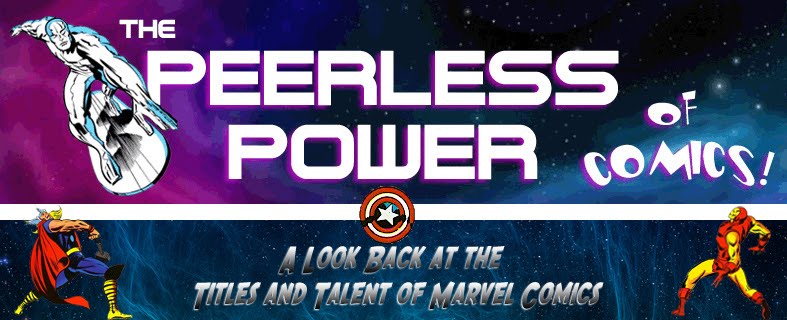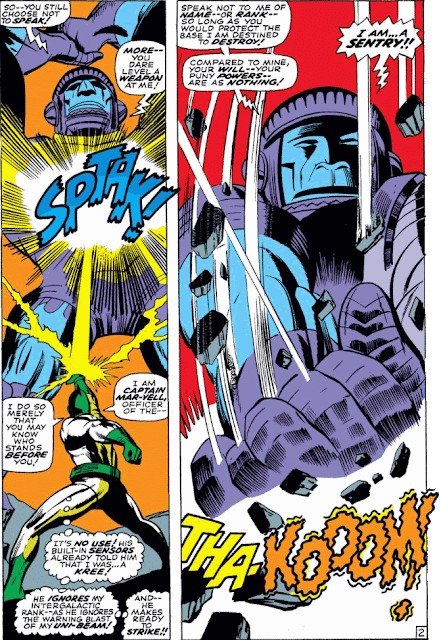OR: "Your Orders Are What I Say They Are, Clown!"
With his introduction in mid-1967 that featured him squaring off against the world's greatest super-team, the sinister Sentry heralded into comics the alien race known as the Kree, whose aggression and goals of conquest led to conflicts with Captain Marvel, the Avengers, and the uncanny Inhumans, as well as the Shi'ar and certainly the Skrulls. Interestingly, the Fantastic Four were left by the wayside as the Kree began to widen their exposure in Marvel stories--perhaps mostly due to the fact that, six months after the FF's defeat of both the Sentry and Ronan the Accuser, the Kree would be diverted to facilitate the appearance of a brand new Marvel character.
Premiering in the pages of Marvel Super-Heroes, Captain Mar-vell of the Kree had been sent to Earth as part of a task force to investigate the destruction of their Sentry as well as Ronan's defeat and invoke appropriate countermeasures to make it clear to Earth that the Kree were not to be defied. As we can see by the cover of the succeeding story, reports of the Sentry's demise were obviously premature, with Marvel apparently using the "bump" from the android's FF appearance to promote interest in the budding "Captain Marvel" character.
As for Mar-vell, at this point in time he's still very much the dutiful Kree soldier, following his orders to the letter and prepared to carry out whatever retaliation his superiors deem fit for the planet.
The underlying conflict of Mar-vell's mission, however, is not so much his interaction with humans and his experiences in infiltrating their installations, but rather his prickly relationship with his c.o., Colonel Yon-Rogg, who is intensely jealous of Mar-vell's romantic relationship with their crew's medic, Una, and undermines Mar-vell at every opportunity in order to ensure that he'll meet his death on Earth. It's a questionable approach to the book, with the Kree threat being limited to Yon-Rogg's petty behavior towards Mar-vell while the Kree race itself is kept at arm's length across the galaxy, with only brief communiques touching base with them and vice versa.
Whether it was wise to remove the Kree from Fantastic Four just as they were building steam and instead using them exclusively in the developing story of Mar-vell is debatable, given how the Kree practically became bit players as Mar-vell was given one makeover after another in an effort to sustain readership. Through it all, however, and in stories to come, the Sentry would come to represent the Kree ambition and arrogance--as well as their intractable will.
How odd, then, that Mar-vell is pictured battling a creation of the Kree, given that he's still very much in their service. Why wouldn't he instead join forces with the Sentry in its rampage? Yet when he stumbles upon the remains of Sentry 459, recovered from the ocean, he seems content to let sleeping dogs lie, at least for the time being.
Mar-vell here is in the guise of Dr. Walter Lawson, who was killed on his way to the base when Yon-rogg destroyed his plane in an attempt to target Mar-vell. Examining Lawson's papers and discovering that he was a missile guidance specialist, Mar-vell decided to assume his identity as a way to more easily gather information on those he spies on. We're also seeing the first appearance of Carol Danvers, in charge of security for the base--probably the last job anyone would want, given the trouble that Mar-vell brings with him.
As for why Mar-vell isn't keen on seeing the Sentry on its feet, we have Yon-rogg to thank for putting in motion another petty scheme to dispose of his rival for Una's affections, thereby making him responsible for Mar-vell inadvertently taking the first steps to becoming the Earth's newest hero.
The cliffhanger would serve to segue Mar-vell into his own title--though thanks to the final page's caption, there wasn't likely any love lost from those readers who plunked down a quarter for the next MSH issue and found no trace of the story they were promised.
The battle which follows is really one that should have stopped before it started. Instead, the Sentry not only refuses to stand to in the presence of one of the Kree, but actually lashes out at Mar-vell--behavior which, from what we know of the Sentry and its loyalties to the Kree, is absolutely absurd. The Sentry will doggedly follow the orders that it's given by any member of the Kree--and, by extension, any orders that countermand its previous instructions. And what better Kree for the Sentry to obey than a member of its military?
It would be one thing if Yon-rogg corrupted the Sentry's programming, but he simply pulled the trigger, so to speak--which leaves us with the battle itself, one that seems a bit one-sided. Not only has the Sentry become self-repairing and thus can counter any damage that Mar-vell is able to inflict--but Mar-vell's own might (due mainly to his suit, another aspect to his character that works against him) is offset by the Sentry's strength as well as its advantage in both bulk and height.
Mar-vell's only hope, than, is his modified wrist uni-beam--insufficient to destroy the Sentry on its own, but capable enough to perhaps cause the Sentry to do the job himself.
It's not the first time Sentry 459 has been presumed destroyed, nor would it be the last. Regardless, the end of the immediate crisis leaves Mar-vell at a crossroads--wondering if, in time, his duty will force him to become an even deadlier menace to the humans than the Sentry.
These events include scenes from Marvel Super-Heroes #13 and Captain Marvel #1.


















No comments:
Post a Comment